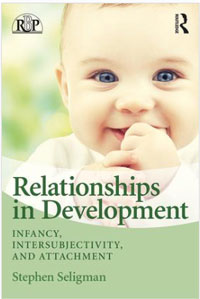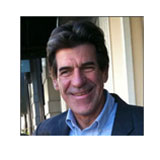Interviewed by Christina Emanuel (USA)
 Stephen Seligman’s (USA) recently published book, Relationships in Development: Infancy, Intersubjectivity, and Attachment (Routledge, 2018), is an important work of integrative scholarship in which he traces the place of images of infancy in psychoanalytic theory and clinical work and shows how an understanding of infants and children informs our psychoanalytic models, allowing us best to help patients of all ages. In his relational-developmental model, Seligman integrates themes from classical and contemporary psychoanalysis, infant research and attachment theory, and more, arguing that “it is not only possible, but necessary, to think in several registers at once” (p. 72).
Stephen Seligman’s (USA) recently published book, Relationships in Development: Infancy, Intersubjectivity, and Attachment (Routledge, 2018), is an important work of integrative scholarship in which he traces the place of images of infancy in psychoanalytic theory and clinical work and shows how an understanding of infants and children informs our psychoanalytic models, allowing us best to help patients of all ages. In his relational-developmental model, Seligman integrates themes from classical and contemporary psychoanalysis, infant research and attachment theory, and more, arguing that “it is not only possible, but necessary, to think in several registers at once” (p. 72).
Christina Emanuel: Congratulations, Steve, on the publication of your book. I found it to be written with clarity and thoughtfulness, which I can’t imagine was easy to do given the breadth and depth of the historical, theoretical, and clinical themes that you so meticulously describe and integrate. What was the process of writing this book like for you?
Stephen Seligman: I began with Mitchell’s influential metaphor of the baby, taking off from there. I found that it could be quite useful to have an account the evolution of the idea of childhood in the history of psychoanalysis, especially in regard to infancy and development itself. The infant is the vehicle by which analytic theories express and buttress accounts of the mind and the properties of human nature. In writing this book I wanted to explore how childhood and infancy could be used in this way.
I also thought it was important to locate the evolution of developmental psychoanalysis in the broader historical and cultural contexts. For example, Freud’s original circle did not include women. The women who were interested in psychoanalysis instead became involved outside the consulting room, working with children, in schools, and with their own children, which rapidly led to the development of child psychoanalysis. These women psychoanalytic leaders, such as Anna Freud and Melanie Klein, became the most prominent members of the next generation.
A second focus of my book addresses my longstanding interest in bridging infant developmental research and clinical infant work – such as Selma Fraiberg’s “Ghosts in the Nursery” model – on the one hand and psychoanalysis on the other. When writing this book I included concepts that I feel best capture these themes, including vitality, activity, complexity, integration, recognition, attachment, intersubjectivity, attention, and others. These dimensions are crucial to the psychoanalytic process, cutting across different persuasions. This second focus swung me back to my original project showing how important it is to know about the developmental process and the real world of children and how much that can contribute to analytic practice and theory building, placing this in the context of a relational-intersubjective envelope.
CE: What are the most important ways you hope readers will use the ideas in your book?
SS: First, I’d like readers to know about real children, their bodily development, the development of their thinking, and the development of their emotional life, all of which are really helpful in the practice of psychoanalysis. I would like clinicians to be more aware of how they think about their patients’ childhoods and infancy in their clinical work.
CE: Don’t psychoanalysts in general already do this?
SS: I feel that analysts are not always committed to thinking about real children, their way of seeing the world, their smallness, helplessness, great exuberance, emotions that are not always symbolized, and the quality of their fantasy life and play. It’s important to think about how these things might translate into an adult patient.
A second aim of this book is to show that it is possible to think in terms of relationships and the development of intersubjectivity, while also making use of some of the strongest parts of traditional psychoanalytic concepts.
CE: Indeed, while situating yourself within the intersubjective-relational orientation, you also mention how critically important it is to explore the “radically intrapsychic” side of Freud’s early models and beyond. As you put it, “The risks of insularity in psychoanalysis seem to me to be greater than those of diffusion” (p. 72). What implications do your ideas have for psychoanalytic training?
SS: I think that development needs to be an important part of psychoanalytic training. For me, this would stress exposure to the extent possible to the real experience of actual children, their physical and cognitive development, neurodevelopment, along with the more abstract analytic concepts, to convey both old traditions and the more contemporary ideas. I also think that classical ideas, like primary process, fantasy, the topographic view of the unconscious, and many more, should be included.
CE: Do you feel people in our midst are conversant with classical concepts?
SS: I think many of us could benefit from going back to some of our original concepts. The traditional theories of Freud, Klein, and the Middle Group offer great resources for Relational analysts. We’re at a point where can move from the original project of appropriately criticizing those schools to incorporating them and re-reading them from an intersubjective perspective, in order to bring greater depth and intensity to our own work. For example, the focused and attentive approach of the traditional psychoanalyst can be very helpful, especially when we understand it as a form of interaction.
CE: One of the things I notice about your writing is your capacity to capture nuance and important distinctions as you link concepts historically and theoretically, such as in your discussion of projective identification in chapter 15. What are your thoughts about seeking precision in psychoanalytic language?
SS: My interest in reading my way through theory has been to capture nuance and details that makes theory as vivid, experience-near, and user-friendly as possible. That’s where development comes in, as thinking about children helps our formulations become more experience-near. My book offers illustrative clinical examples and includes links and an accompanying website with videos and other links that bring these concepts to life (www.routledge.com/9780415880022, click on eResources tab).
But some psychoanalytic concepts are laden with historical and conceptual baggage that makes it harder to get experience-near with them. They are also laden with institutional baggage, with some concept or other belonging to one group or another. For example, projective identification “belongs” to the Kleinians, and rests on a view of infancy and splitting that is not how I want to use it. I think of projective identification as a form of relationship that spans the internal and external worlds of individuals.
CE: Chapter 14 includes a detailed case in which you illustrate clinically and elegantly the themes in your book. What are your impressions of the nature and evolution of psychoanalytic writing in general?
SS: Clinical writing is hard to do well. It’s a special writing genre that conveys so much. Relational analysis has transformed clinical writing in the direction of writers being more open about their experience, a fundamental and important change in the last decades. Sometimes clinical writing can get sensational, where readers are inadvertently misled to think that there’s some king of magic moment that changes things around. We could all benefit from putting more of the quotidian, everyday aspects of our work into clinical writing.
CE: Now that you have completed your book, what other projects and activities are you focusing on?
SS: I am speaking a lot about the material that’s in the book, traveling soon to Rome, London, and Korea, in addition to various cities in the US. Italian and Korean translations of my book will be launched this fall.
There’s a freedom that comes from finishing this book. I’m trying to sort out what I’m most interested in thinking and writing about next, and what sources outside of psychoanalysis can be enriching to my analytic work. I’m curious and hopeful to see where that takes me.
CE: Thank you, Steve, for this interview, and for your many important contributions to psychoanalytic scholarship.
Link to the publisher: https://www.routledge.com/Relationships-in-Development-Infancy-Intersubjectivity-and-Attachment/Seligman/p/book/9780415880022
 Stephen Seligman, DMH
Stephen Seligman, DMH
Email Stephen Seligman


